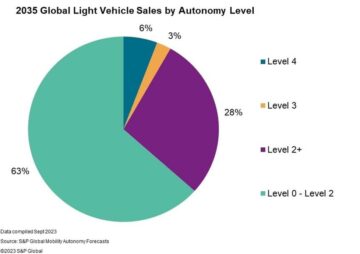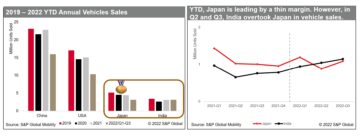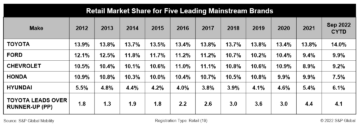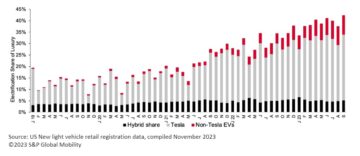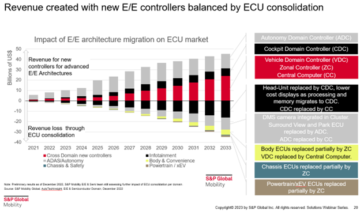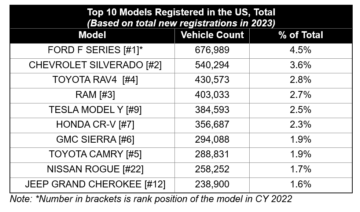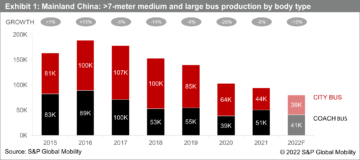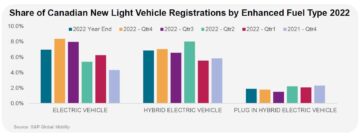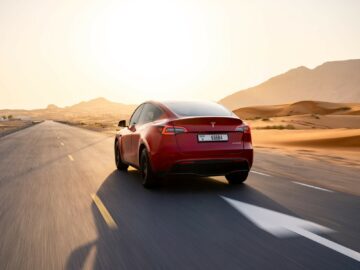The regulations currently in discussion will propel BEV
shares above 50% in Europe by 2030. China and the US will reach 40%
and 25% BEV respectively.
Many countries have committed to become carbon-neutral economies
by 2050 (China by 2060). IHS Markit is tracking these developments
closely and offers new analysis on the transformation of the
transport sector that will be required to meet these targets.
To succeed, the transportation sector will need to turn many of
the vehicles in operation into battery electric vehicles (BEVs) or
zero emission vehicles (ZEVs) within the proposed timeframes. In
turn, internal combustion engine (ICE) and hybrid vehicle sales
will need to be phased out at least 10 years before the target
dates, with many markets becoming pure BEV/ZEV sales markets by
2040 at the latest (with only few exceptions), according to IHS
Markit estimates.
Europe is in the vanguard of this transformation from a
regulatory perspective. Although not formally agreed yet, IHS
Markit expects an EU-wide ICE phase-out by 2040 or before. Indeed,
nine EU member states are lobbying publicly for 2035 or an earlier
timing. A new CO2 reduction target for OEMs is likely to
see a 55% reduction on 2021 levels (instead of 37.5% today). To get
there, BEV/ZEV sales will need to be greater than 50% by 2030.
Regardless of the CO2 reduction target or EU7 norm, the
ICE sales era will be replaced by the BEV sales era between 2035
and 2040. Meanwhile the window of opportunity for hybrid vehicles
as a transition technology will be short. Independent from EU-wide
regulations, some countries are on their own timeline, using the
few options which are in-line with EU-legislation to create de
facto ICE bans. Norway has used high ICE taxes and BEV incentives
over the years to meet its target by 2025. The Netherlands will
rely on low-emission zones to reach its target by 2030. After
Brexit, the UK can introduce the announced ICE ban after 2030 with
exceptions for selected hybrid vehicles during a transition
phase.
From a regulatory perspective, China is only a few years behind
Europe. IHS Markit expects New Energy Vehicles (NEV) sales targets
to be around 40% by 2030, greater than 50% by 2035 and up to 100%
by 2050 at the latest. Additional CAFC targets in the direction of
3 l/100km by 2030 and 2 l/100km by 2035 (under the WLTC test
protocol) will leave room for only the most fuel-efficient hybrid
vehicles alongside NEVs.
The U.S. is tied to Safer Affordable Fuel-Efficient (SAFE) rules
until 2026. From 2027 onwards, IHS Markit assumes that Biden’s
administration will revert to the MPG improvement levels which are
at least as stringent as those seen under the Obama administration.
Furthermore, IHS Markit works with the assumption that five states
including California will ban ICEs by 2035. Under these assumptions
a BEV/ZEV new vehicle sales trend of between 25-30% by 2030 and
45-50% by 2035 is expected.
OEMs accelerate their electrification plans with less
room for platform, vehicle and powertrain complexities other than
BEVs
The upcoming regulations described above will require minimum
BEV sales shares of more than 50% in Europe, more than 40% in China
and more than 25% in the U.S. by 2030, according to IHS Markit
analysis. This will lead OEMs to a deep review of their technology,
platform, vehicle and powertrain strategies. They are also
wrestling with the required investments to become successful with
BEVs and the perspective of the financial markets to support these
investments.
“The tipping point for decisions towards an accelerated BEV
roadmap or even a full BEV switch has arrived in the board rooms of
major OEMs in regulated markets,” said Reinhard Schorsch, Director,
OEM Planning Solutions at IHS Markit.
Consequently, Jaguar, Volvo, Mini, Bentley and Ford Europe have
announced ambitions to become BEV brands by 2030. Other brands are
striving make BEVs their major propulsion system by then. These
include Porsche (80% BEV), VW Europe (70% BEV), Land Rover (60%
BEV), BMW (50% BEV) and Kia Europe (50% BEV). BEV related
announcements for 2035, such as GM’s aspiration to be fully
tailpipe emission free, seem to be self-evident in this
context.
OEMs with big sales footprints in fewer or non-regulated markets
are still hesitant to make the move towards BEVs. While it might
only be a matter of time for a big player such as Toyota, others
might be left in an uncertain ICE world, especially if they try to
establish and to secure a BEV supply chain too late.

Regulations enforce the move towards BEVs/ZEVs, OEMs
plan according to or even beyond regulation compliance, but markets
and customers need to be ready
“Broad consumer acceptance and readiness for BEVs will occur
when price and total cost of ownership match with mobility budgets,
when real driving ranges match with use cases, and when charging is
no longer a concern in consumer’s mindsets,” according to
Schorsch.
Due to incentives, price parity between BEVs, ICEs and hybrids
largely exist today. When incentives run out, however, OEMs will
need to compensate these through cost and price reductions for
BEVs; but perhaps not to the same extent; ICE prices will likely
increase as incumbent OEMs favor profits over volumes. In the end,
the cost leaders (likely none of the incumbent OEMs) will have the
freedom to decide over the exact BEV price levels. Overall, IHS
Markit expects that by 2030, BEV prices will not be an obstacle
constraining demand.
BEV driving ranges continue to improve, and in most cases, are
virtually no longer a restriction for consumers. Customers are used
to a range provided by an ICE that is far beyond their requirements
in most daily use cases. The last decade has brought significant
cost reductions alongside lithium-ion battery technology
advancements, and the next decade is expected to bring significant
range improvements as solid-state batteries become the norm. As a
result, IHS Markit believes that the “range anxiety” problem will
be solved by 2030. Meanwhile, BEVs with greater interior spaces,
enjoyable driving performance, new software and applications will
add to BEV appeal for many consumers and will also reshape segment
structures and differentiation criteria.
Charging infrastructures remain the key questionable factor in
this context – market by market. They can be developed over time,
but it is yet to be seen if their development speed will keep pace
with the development of the other factors driving demand.
The direction is obvious in regulated markets, but the
road ahead is not straight
Will commitments to carbon-neutral economies be fulfilled and
will the consequent regulations be put in place? Will the OEMs’
accelerated electrification plans be supported by the supply chain
and will their BEVs match with customers’ expectations in the same
timeframe? While the answers to the general questions might be
obvious, the answers to the detailed questions still bear risks. At
this point however, it is rather less risky to prepare for the BEV
era, than to miss it.
- Additional
- analysis
- announced
- Announcements
- Anxiety
- appeal
- applications
- around
- aspiration
- automotive
- automotive industry
- Ban
- Bans
- batteries
- battery
- Battery Electric Vehicles
- biden
- BMW
- board
- brands
- Brexit
- california
- cases
- charging
- China
- compliance
- consumer
- Consumers
- continue
- countries
- Customers
- Dates
- Demand
- Development
- Director
- driving
- Electric
- electric vehicles
- emission
- energy
- estimates
- EU
- Europe
- expects
- financial
- For Consumers
- Ford
- Free
- Freedom
- full
- General
- GM
- High
- HTTPS
- Hybrid
- ICE
- Including
- Increase
- industry
- Investments
- IT
- jaguar
- Key
- Kia
- land rover
- latest
- lead
- lobbying
- major
- Market
- Markets
- Match
- mobility
- move
- Netherlands
- Norway
- Obama
- Offers
- Opportunity
- Options
- Other
- Others
- performance
- perspective
- planning
- platform
- player
- Porsche
- price
- range
- Readiness
- Regulation
- regulations
- Requirements
- review
- Rooms
- rover
- rules
- Run
- safe
- sales
- selected
- Shares
- Short
- Software
- Solutions
- speed
- States
- successful
- supply
- supply chain
- support
- Supported
- Switch
- system
- Target
- Taxes
- Technology
- test
- the Netherlands
- time
- Tipping
- Tipping point
- toyota
- Tracking
- Transformation
- transport
- transportation
- u.s.
- Uk
- us
- vehicle
- Vehicles
- volvo
- vw
- within
- works
- world
- years
- zero

